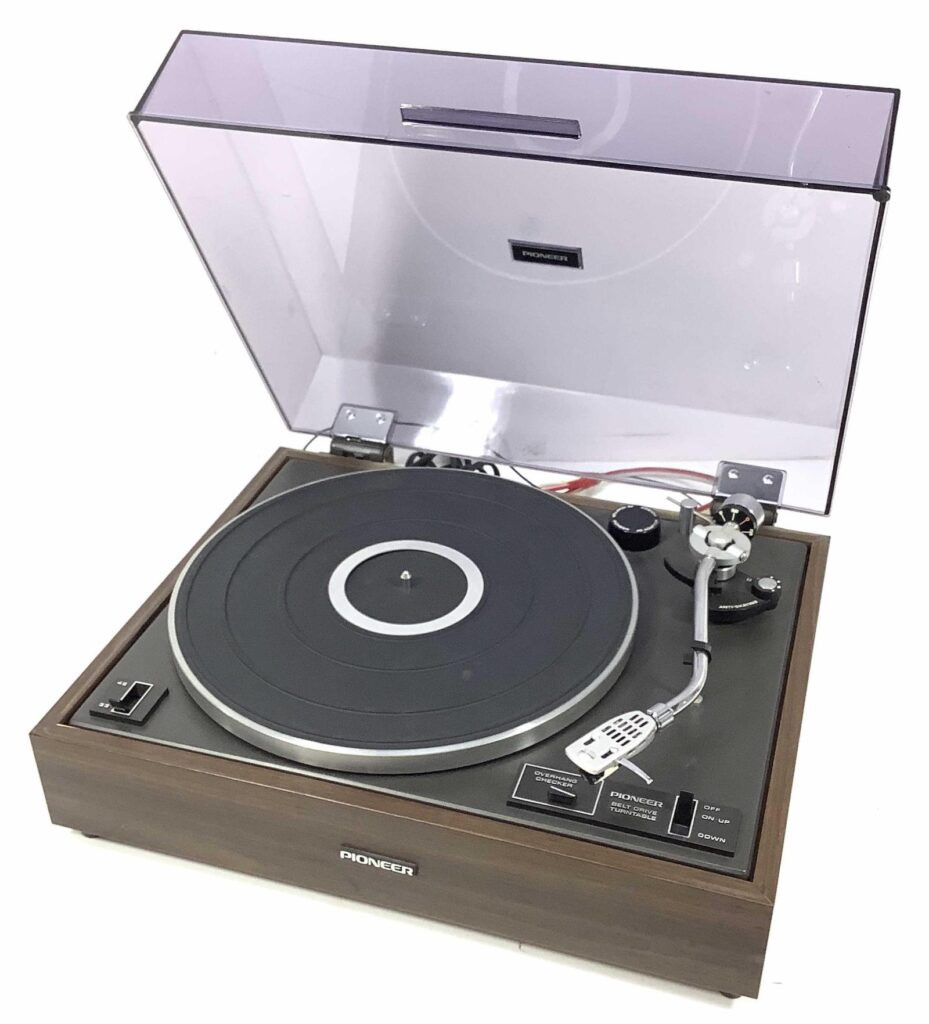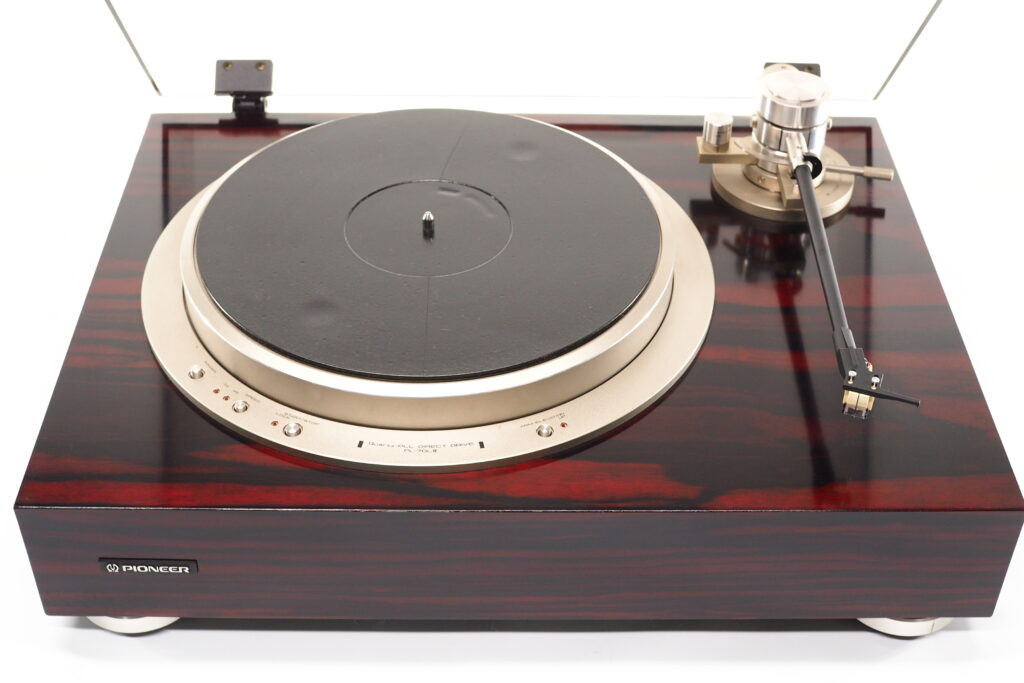If you’ve been browsing for vintage audio equipment, encountering Pioneer components is almost inevitable. Founded in Tokyo in 1938 by Nozomu Matsumoto, Pioneer began its journey focusing on speaker manufacturing. Their foray into Pioneer Turntables in the early 1960s, with a full commitment in the 1970s, showcased the same dedication to precision and quality. From the celebrated PL-12D in the 70s to high-end marvels like the PL-70LII, pioneer turntables became essential fixtures in both home listening setups and professional environments. Due to Pioneer’s widespread success, the used market is rich with options, offering enthusiasts a chance to own a piece of audio history. The brand has produced over 200 distinct pioneer turntable models, with over 100 debuting in the 1970s alone.
These turntables, typical of their era, were designed not just for performance but also to be visually impressive, meant to be a centerpiece in your living space and a lasting component of your music enjoyment. Until recently, these ubiquitous pioneer turntables were often overlooked in the vintage market frenzy, overshadowed by brands like Technics, Thorens, and Garrard. However, this perception has shifted, and prices for pioneer turntables have been on a significant rise. Despite this, opportunities to find good deals still exist – keep an eye on platforms like Facebook Marketplace, Craigslist, and eBay.
Leveraging comprehensive data from Akadatabase.org and advanced data analysis, we’ve examined the entire range of pioneer turntables dating back to 1960. This analysis provides not only a detailed overview of approximately 236 models but also insights that largely align with current trends in the used market, helping you navigate the world of vintage pioneer turntables.
Below are some standout models worth seeking out when exploring pioneer turntables.
 Pioneer PL-41 vintage turntable in wood cabinet
Pioneer PL-41 vintage turntable in wood cabinet
Pioneer’s Entry into Turntables: The Mid-1960s Collection
While Pioneer introduced a few pioneer turntables in the early 1960s, their full commitment to this audio category became evident in 1966. This year marked the release of several models designed to meet diverse audiophile needs and preferences. Among these early models was the PL-6A, a belt-drive pioneer turntable celebrated for its straightforward design and consistent, reliable playback. Engineered for user-friendliness, the PL-6A was specifically targeted at listeners conscious of budget without compromising audio quality. Alongside the PL-6A, Pioneer also launched the PL-21, another belt-drive pioneer turntable, but this model offered enhanced build quality and improved performance, appealing to a slightly more discerning audience. Furthermore, Pioneer aimed at the more serious audiophile segment with the introduction of the MU-7 and MU-41 models, the latter shown in the image above.
The MU-7 and MU-41 pioneer turntables were distinctive as they were sold without a base or plinth. This design choice allowed users to personalize their audio setups by crafting custom plinths, reflecting the burgeoning DIY and customization trends in audio at the time. The MU-7 and MU-41 were instrumental in establishing Pioneer’s reputation as a brand that understood and catered to the sophisticated demands of high-fidelity enthusiasts and serious audio spenders, paving the way for their subsequent global success in the pioneer turntables market and beyond.
 Pioneer PL-90 high-end turntable in minimalist design
Pioneer PL-90 high-end turntable in minimalist design
The High-End Pioneer PL-90 Turntable
Released in 1989, the PL-90 stands out as one of the most premium and sought-after pioneer turntable models, originally priced at $900. This model is a part of Pioneer’s esteemed Elite series, known for its sophisticated, minimalist aesthetic, emphasizing both functionality and visual elegance. Introduced in the late 1980s, the Elite range was specifically developed to cater to serious audiophiles and the growing market of home theater enthusiasts, representing the pinnacle of pioneer turntable engineering at the time. “The PL-90 is a substantial piece of equipment that demands considerable space, but it’s a visual highlight,” commented one owner on Vinyl Engine, highlighting its physical presence and aesthetic appeal. Another owner added, “A HUGE, heavy turntable with an enormous platter, it’s large, heavy, and requires significant space. Features a smoked-grey dustcover. In Japan, it was marketed as the PL-7 in black, while the US version came in a glossy woodgrain finish to align with the Elite product line,” detailing its specifications and market variations. The Pioneer PL-90 remains a testament to Pioneer’s capability to produce high-end pioneer turntables that appeal to both the auditory and visual senses of discerning audiophiles.
 Pioneer PL-12D vintage turntable with belt-drive system
Pioneer PL-12D vintage turntable with belt-drive system
Pioneer PL-12D: The Game-Changing Turntable
The Pioneer PL-12D, launched in 1972, was a pivotal model for the company and significantly disrupted the landscape of affordable hi-fi pioneer turntables. Renowned for its belt-driven mechanism, robust construction, and user-centric features, the PL-12D was strategically priced to attract a wide spectrum of consumers. Its refined design and consistent performance quickly established it as a favored option for individuals new to the vinyl listening experience and seasoned audiophiles alike. The PL-12D’s commercial success underscored Pioneer’s proficiency in delivering high-caliber audio equipment that effectively addressed market demands during an era when vinyl records were the dominant music format. This model is often cited as a key example of a pioneer turntable that democratized access to quality audio.
In the fiercely competitive market of the early 1970s, the PL-12D effectively competed with models like the Thorens TD-150 and Dual 1219. While these competitors were also recognized for their advanced engineering and superior sound reproduction, they often came with a higher price point. The pioneer turntable PL-12D struck an optimal balance, offering a well-engineered tonearm and suspension system that rivaled more expensive models. While brands such as Technics and Garrard were pushing boundaries with their own innovations, the PL-12D carved out a significant market share by providing a belt-drive system that appealed to audio purists, firmly cementing Pioneer’s position as a leading brand in pioneer turntables and the broader audio industry.
 Pioneer PL-70LII direct-drive turntable with advanced tonearm
Pioneer PL-70LII direct-drive turntable with advanced tonearm
The Sophisticated Pioneer PL-70LII Turntable
The visually stunning Pioneer PL-70LII, introduced in 1981, emerged during a highly competitive period in the pioneer turntable market, where brands such as Technics, Thorens, and Linn were dominant forces. Its direct-drive motor delivered exceptional speed stability, a critical feature during a time when debates about the merits of belt-drive versus direct-drive systems were intense among audio enthusiasts. The PL-70LII’s substantial platter and sophisticated tonearm, which incorporated improvements over the earlier PL-70L, were designed to minimize unwanted vibrations and noise, enhancing sonic purity. This model is highly regarded in discussions about top-tier pioneer turntables.
In the early 1980s context, while Technics’ SL-1200 series was gaining prominence with its robust build and DJ-friendly features, the PL-70LII positioned itself as a more refined and audiophile-focused alternative within the pioneer turntable lineup. It masterfully combined Pioneer’s technological prowess with an elegant aesthetic, making it not only a high-performance audio component but also a coveted collector’s item. The enhancements in motor isolation and tonearm precision over its predecessor ensured that the PL-70LII remained competitive against its contemporaries, delivering a listening experience that was highly esteemed in high-fidelity circles and solidifying its place among the best pioneer turntables ever produced.
 Pioneer PL-L1000 linear tracking turntable system
Pioneer PL-L1000 linear tracking turntable system
Pioneer PL-L1000: Pioneering Linear Tracking Technology
Featuring an innovative linear tracking system, the PL-L1000, also released in 1981, marked a significant advancement in pioneer turntable technology. Unlike conventional pivoted tonearms, the PL-L1000’s tonearm moved in a straight line across the record, effectively reducing tracking errors and facilitating more accurate and pristine sound reproduction. The direct-drive system of the PL-L1000 ensured dependable and consistent rotation, crucial for maintaining consistent playback quality. While competing models from brands like Technics and Denon were recognized for their durability and precision, the PL-L1000 became a highly respected choice for audiophiles who prioritized both cutting-edge technology and exceptional sound fidelity in their pioneer turntable selection. This model represents Pioneer’s commitment to innovation and pushing the boundaries of turntable design.
Pioneer turntables have left an indelible mark on the history of audio. From their accessible and game-changing models like the PL-12D to the high-fidelity sophistication of the PL-70LII and the technological innovation of the PL-L1000, Pioneer consistently delivered quality and performance. Exploring the world of pioneer turntables offers a rich journey through audio history, revealing models that continue to be valued for their sound, design, and enduring legacy. Whether you are a seasoned collector or new to vinyl, the diverse range of pioneer turntables provides options for every enthusiast seeking to enhance their listening experience with vintage audio excellence.
